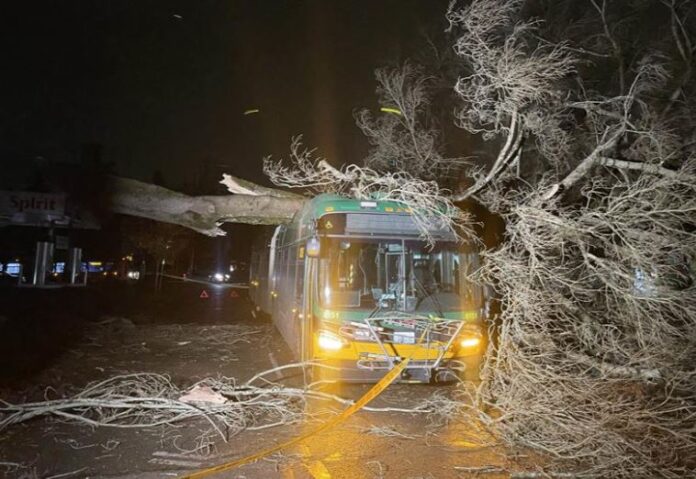A powerful storm slammed the northwest U.S. on Tuesday evening, unleashing fierce winds, heavy rain, and widespread destruction. The system, classified as a “bomb cyclone”, is the strongest atmospheric river of the season for both California and the Pacific Northwest, bringing hurricane-force winds and excessive rainfall that are expected to persist through Friday.

The storm caused significant damage across the region, including downed trees, which led to power outages and blocked roads. In Lynnwood, Washington, tragedy struck when a large tree fell on a homeless encampment, killing a woman late Tuesday night. The South County Fire department confirmed the fatality via social media. In Seattle, a fallen tree also trapped a person inside a vehicle; however, the individual was later reported to be in stable condition.
As winds gusted up to 101 mph (163 kph) off the coast of Vancouver Island, and 79 mph (127 kph) on Oregon’s coastline, emergency services issued urgent warnings across the region. The Seattle Fire Department reported that trees were falling onto homes throughout the city, advising residents to seek shelter on the lowest floor and avoid going outside. Bellevue’s fire department echoed these warnings, urging residents to stay indoors and away from windows.
By early Wednesday, more than 600,000 homes in Washington State were without power, according to PowerOutage.us. However, the accuracy of these figures was difficult to confirm due to internet outages and technical issues faced by weather and utility agencies. Power outages were also reported in Oregon (15,000 homes) and California (nearly 19,000 homes).
The National Weather Service (NWS) reported peak wind speeds of 101 mph (163 kph) off Vancouver Island, with strong gusts of 77 mph (124 kph) recorded at Mount Rainier in Washington and 79 mph (127 kph) along Oregon’s coast. Winds were expected to increase throughout the evening in western Washington.
As the storm continues to wreak havoc, the NWS urged residents on the West Coast to take precautions, warning that high winds could bring down trees and debris. Authorities advised people to avoid exterior rooms and windows and to drive with extreme caution.
In Northern California, flood and high wind watches were issued, with up to 8 inches (20 cm) of rain expected in some areas, including parts of the San Francisco Bay Area and Sacramento Valley. Dangerous flash flooding, rock slides, and debris flows are anticipated in affected regions. Additionally, the National Weather Service issued a winter storm watch for the northern Sierra Nevada above 3,500 feet, with the potential for 15 inches (38 cm) of snow over two days and wind gusts of up to 75 mph (120 kph) in mountain areas.
As if the storm’s fury wasn’t enough, a blizzard warning has been issued for parts of the Cascades in Washington, including Mount Rainier National Park, with up to a foot of snow and wind gusts reaching 60 mph (97 kph). Travel across mountain passes could become hazardous or even impossible.
Ferry routes in northwestern Washington, including the route between Port Townsend and Coupeville, have also been halted due to rough winds and high seas.
Key Points:
A severe storm hit the northwest U.S. on Tuesday evening, bringing strong winds, heavy rain, and widespread damage.The storm, classified as a “bomb cyclone”, is the strongest atmospheric river of the season, with hurricane-force winds and excessive rainfall expected to last through Friday.
Fatalities reported: A woman was killed in Lynnwood, Washington, when a tree fell on a homeless encampment. In Seattle, a person was trapped in a car by a fallen tree but was later reported stable.
Over 600,000 homes in Washington State lost power, with additional outages in Oregon and California.Peak wind speeds included 101 mph (163 kph) off Vancouver Island and 79 mph (127 kph) along Oregon’s coast.
Warnings issued for high winds, fallen trees, and potential flooding: The National Weather Service (NWS) urged people to stay indoors and avoid driving in affected areas.
Northern California faced flood and high wind watches, with up to 8 inches (20 cm) of rain expected, along with flash flooding and rock slides.
A winter storm watch was issued for the northern Sierra Nevada, where 15 inches (38 cm) of snow and wind gusts up to 75 mph were expected.
A blizzard warning was issued for the Cascades in Washington, including Mount Rainier National Park, with heavy snow and high winds forecast.Ferry routes in northwestern Washington were halted due to rough seas and high winds.



